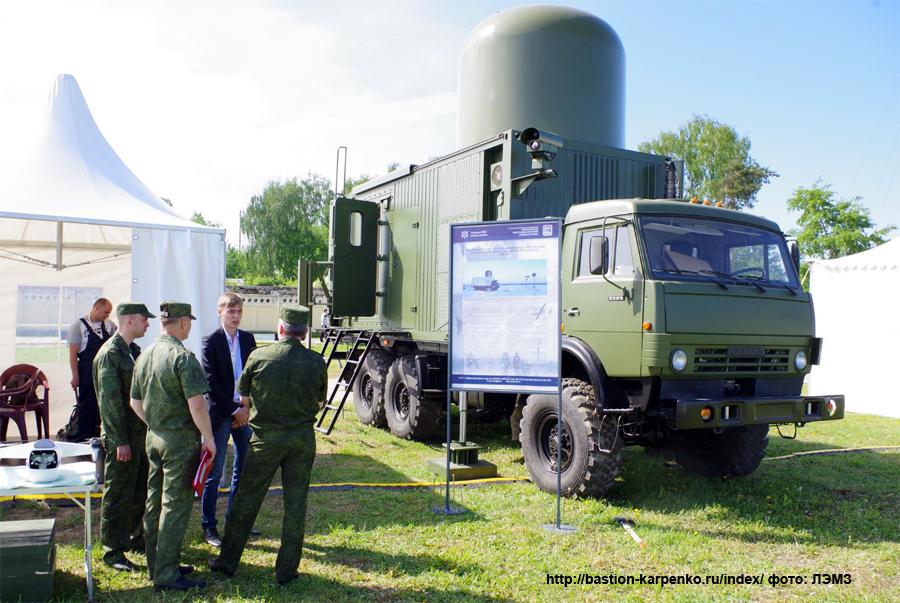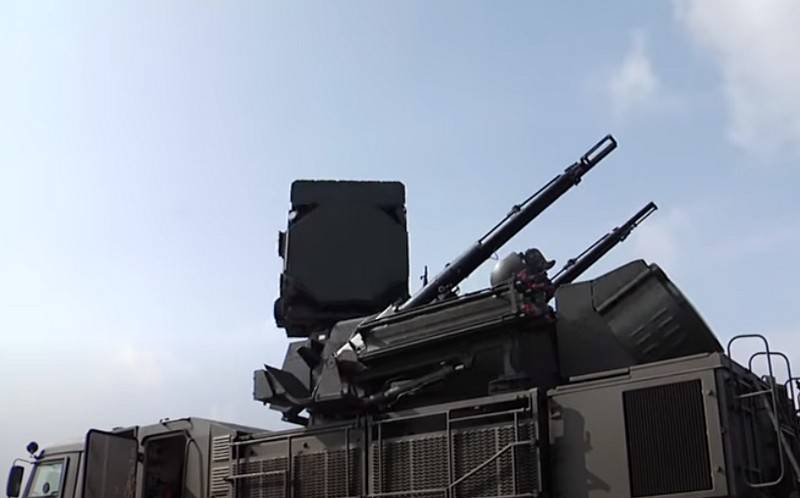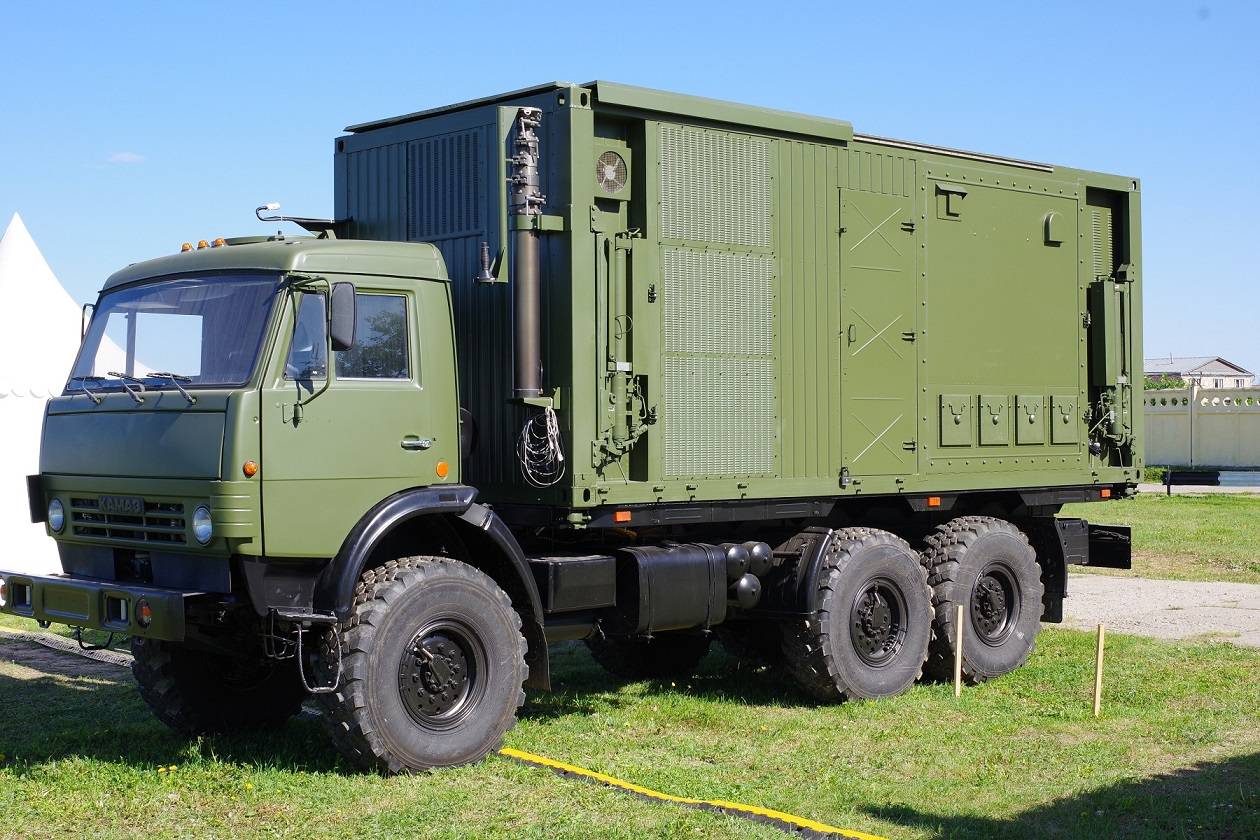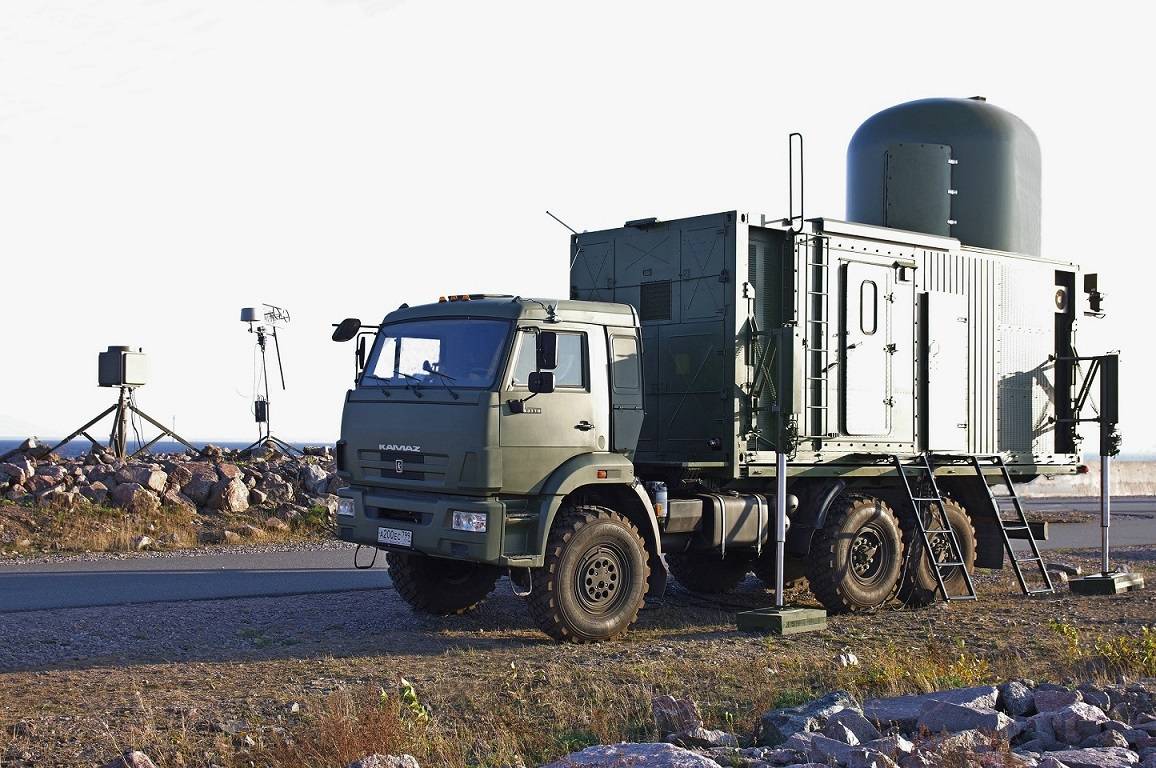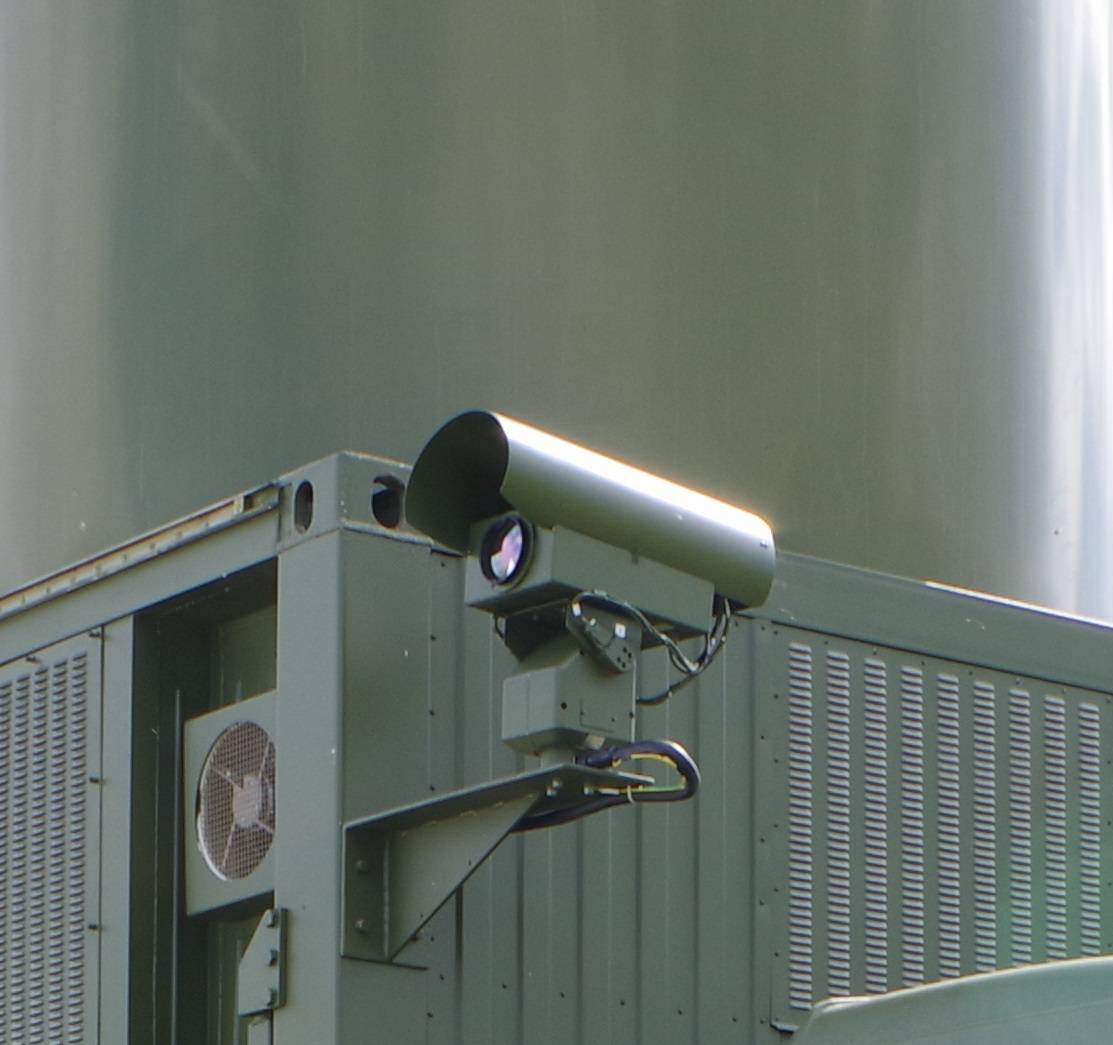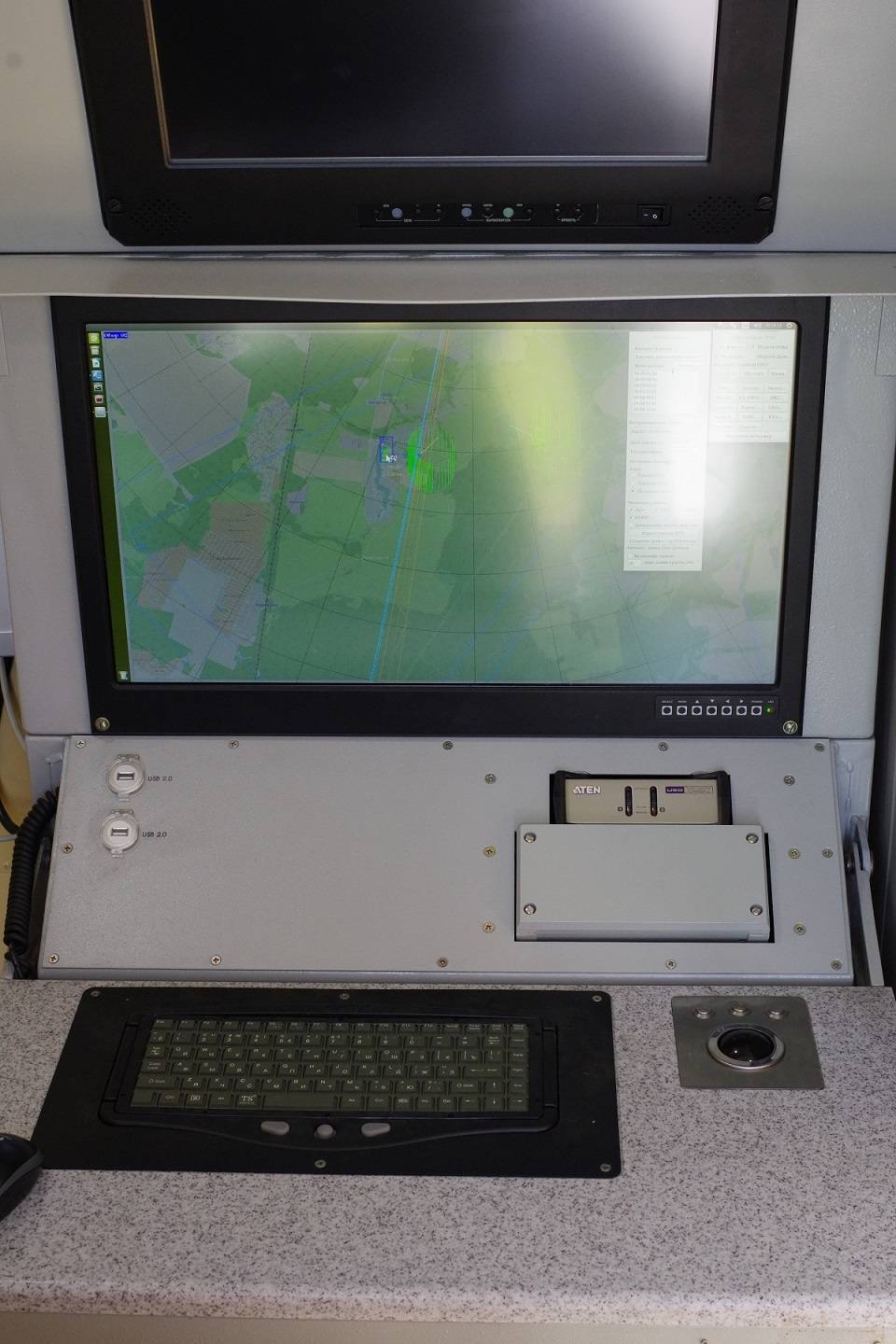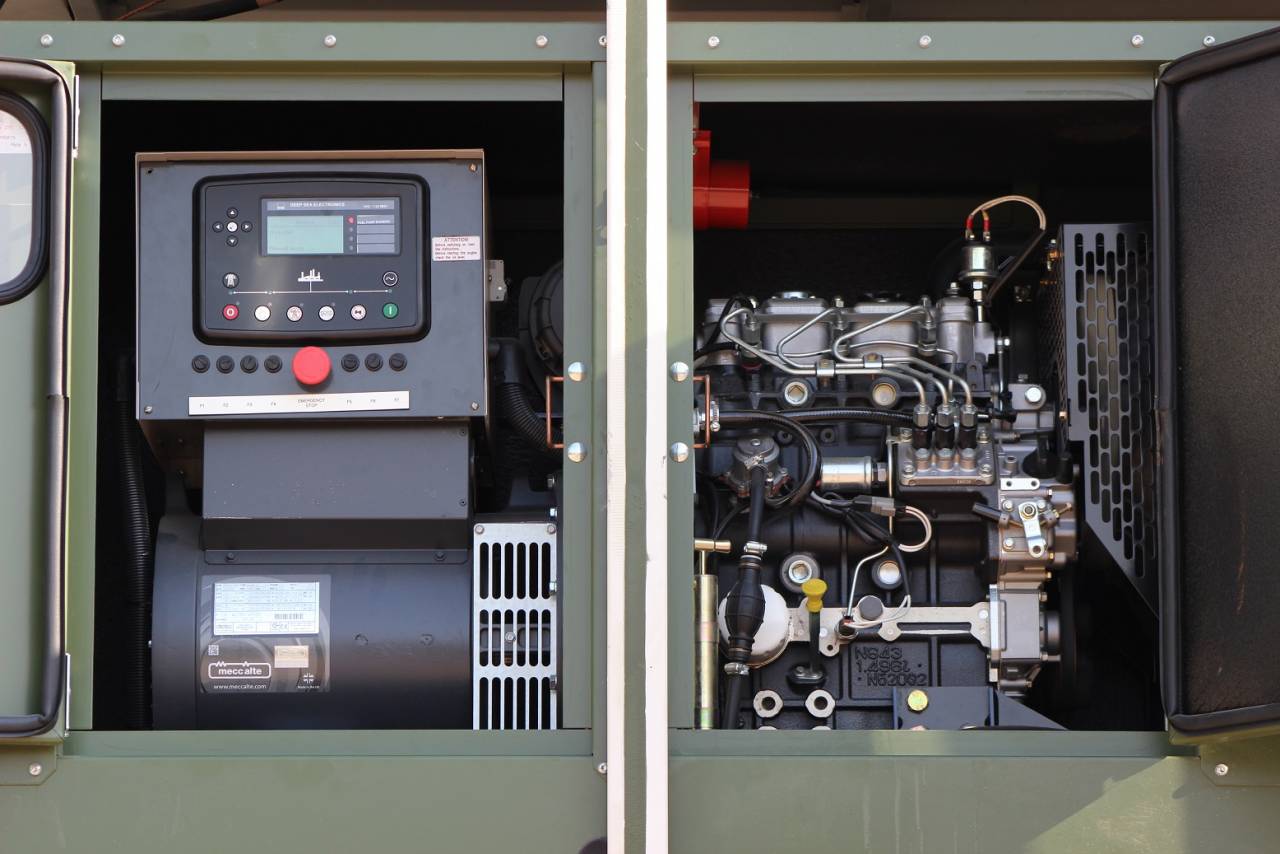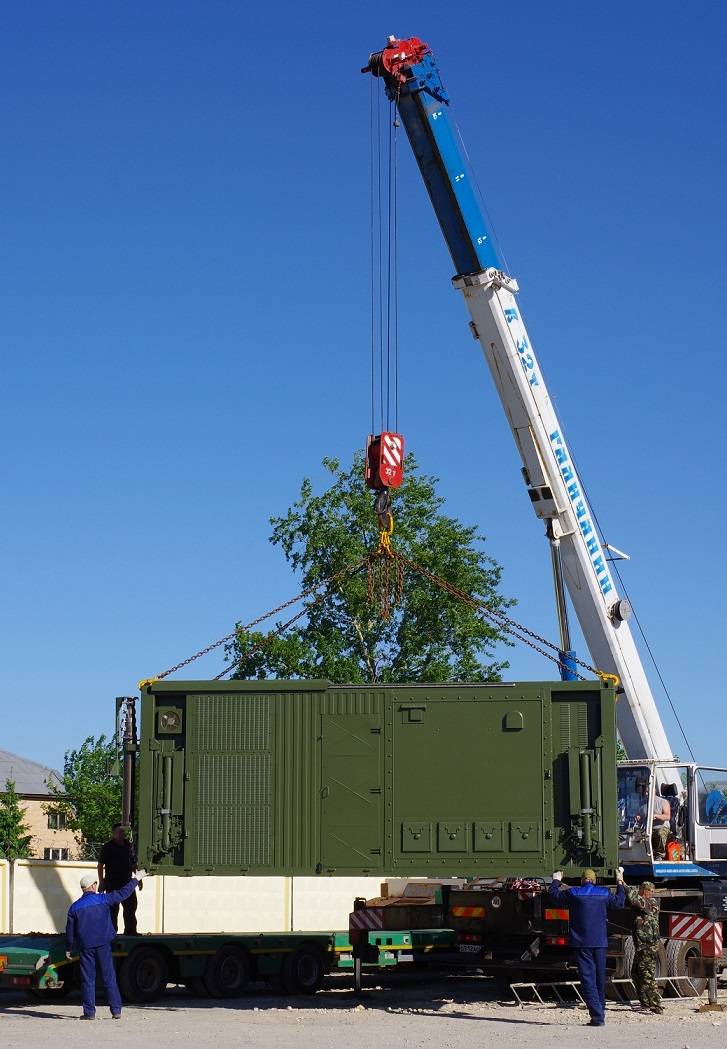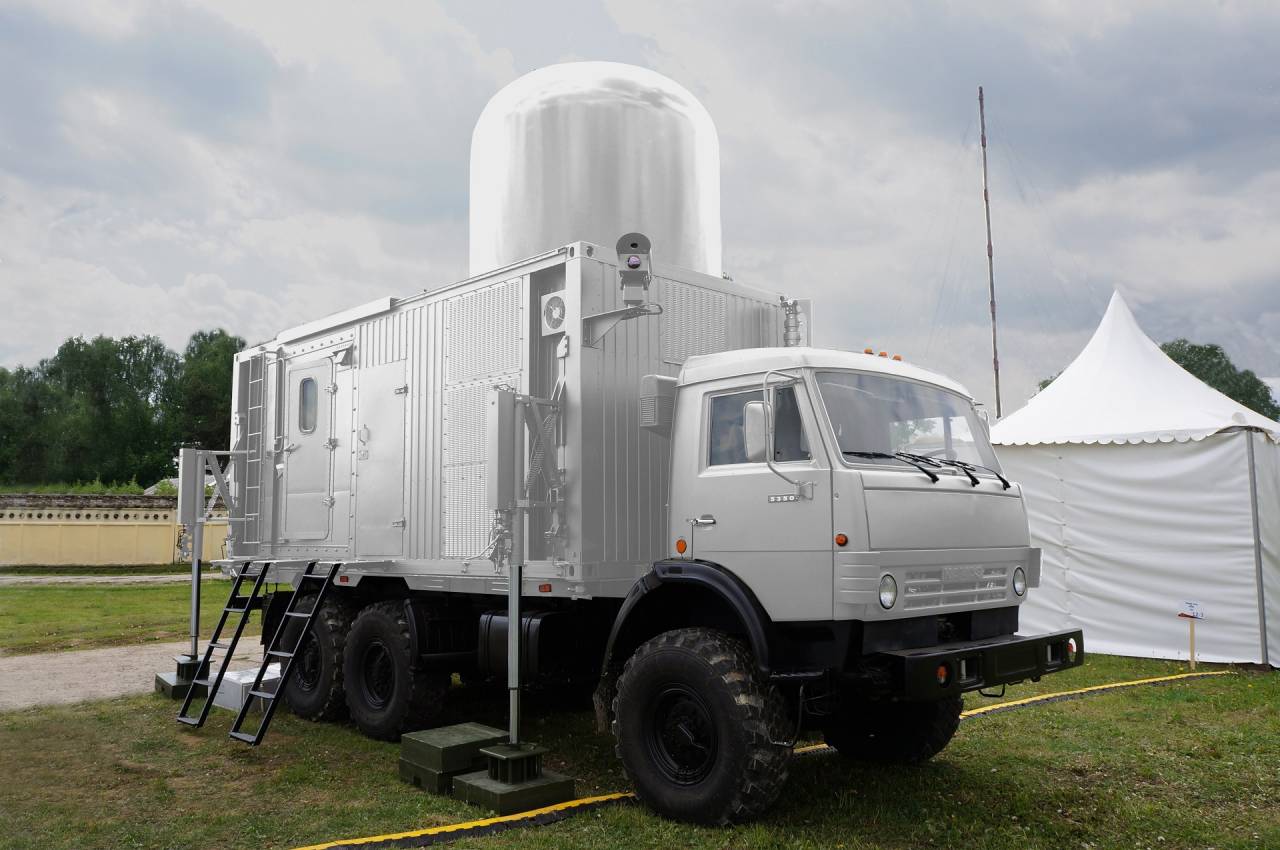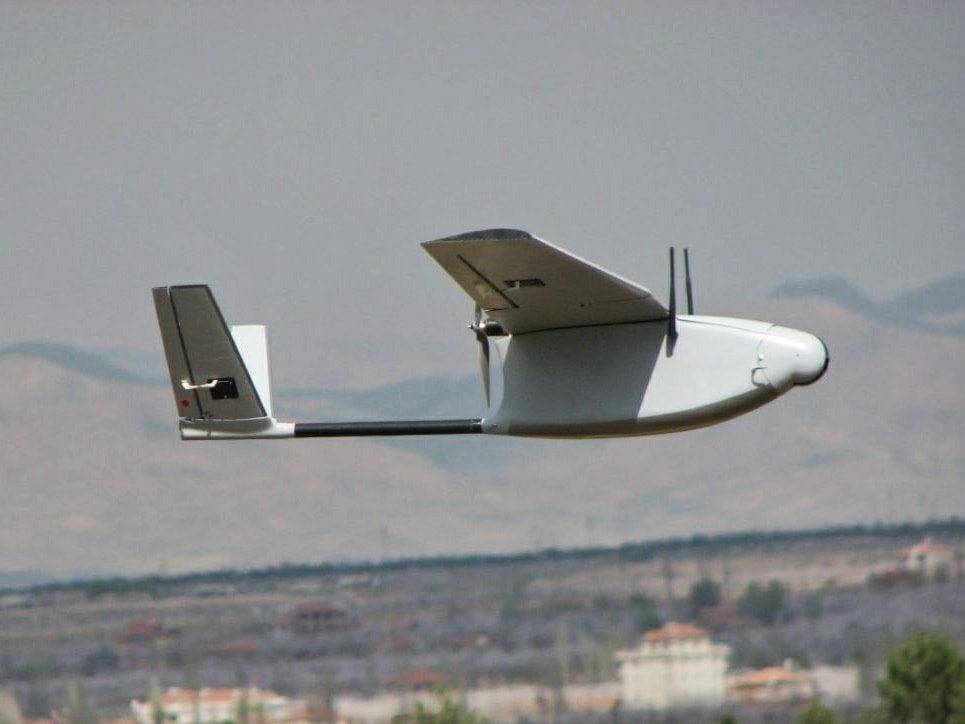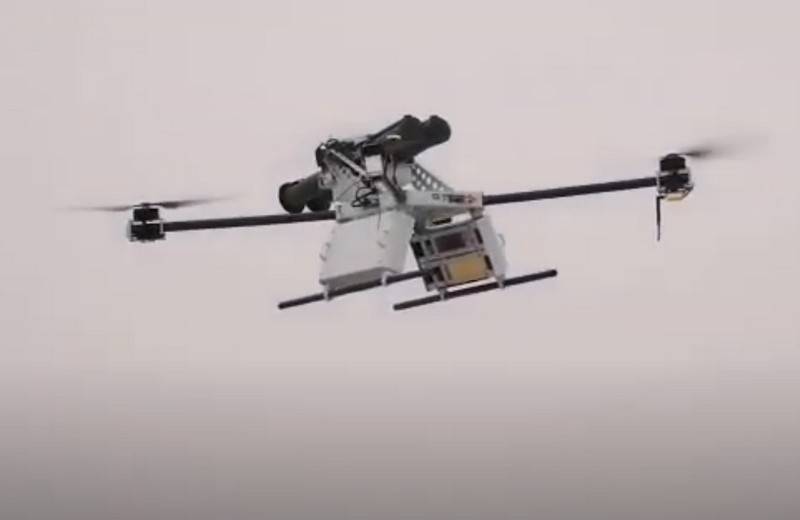The Wolf-18 interceptor drone has successfully completed flight tests
In Russia, the Wolf-18 drone designed to intercept enemy drones was tested. The quadcopter is automatically capable of detecting and then shooting down or ramming air targets.
"Flight tests of the upgraded version of the Volk-18 ,which included a real defeat of target drones, have been successfully completed, "a representative of the Almaz-Antey concern of East Kazakhstan region told RIA Novosti.
The quadcopter received a new optical-location system with an increased range of detection of air targets, as well as a control system with the ability to use the drone in fully automatic mode.
During a barraging flight, the interceptor drone independently scans the airspace to detect, recognize, and select objects.
The operator decides to destroy the target, after which the "Wolf-18" automatically attacks the enemy. To do this, he has three devices for shooting nets. If it is not possible to interrupt the flight of an aerial target with the help of charges, then the RAM function is provided to destroy the enemy vehicle in the air.
The prototype "Wolf-18" is a quadrocopter with dimensions of 60 by 60 centimeters. The flight time of the interceptor drone reaches 30 minutes. Take-off weight - six kilograms.
State tests of the new drone are planned to be carried out before the end of the year
https://z5h64q92x9.net/proxy_u/ru-en.en.d55caf23-60240a08-91ecdec8-74722d776562/https/rg.ru/2021/02/10/dron-perehvatchik-volk-18-uspeshno-zavershil-letnye-ispytaniia.html
+46
TMA1
ucmvulcan
Arkanghelsk
caveat emptor
nomadski
GunshipDemocracy
Backman
franco
Begome
JohninMK
sepheronx
Kiko
Flanky
Atmosphere
Singular_Transform
mnztr
Mindstorm
thegopnik
lyle6
AlfaT8
medo
flamming_python
RTN
Tsavo Lion
Viktor
Arrow
marcellogo
william.boutros
auslander
Cyberspec
kvs
magnumcromagnon
dino00
LMFS
Hole
George1
jhelb
AJ-47
miketheterrible
PapaDragon
Swede55
Isos
d_taddei2
GarryB
Tingsay
The-thing-next-door
50 posters
Russian defence against drone swarms

magnumcromagnon- Posts : 8138
Points : 8273
Join date : 2013-12-05
Location : Pindos ave., Pindosville, Pindosylvania, Pindostan
- Post n°226
 Re: Russian defence against drone swarms
Re: Russian defence against drone swarms
GarryB and LMFS like this post

The-thing-next-door- Posts : 1293
Points : 1349
Join date : 2017-09-18
Location : Uranus
- Post n°227
 Re: Russian defence against drone swarms
Re: Russian defence against drone swarms
How would that thing shoot down other drones?

Atmosphere- Posts : 274
Points : 278
Join date : 2021-01-31
- Post n°228
 Re: Russian defence against drone swarms
Re: Russian defence against drone swarms
I do not understand the hype with drones.
It is a weapon with certain niches to fill. No more. No ''making IADS useless" and no "changing the Battlefield forever".
Some air defence systems were simply cought with their pants down , considering how drones were sent to attack targets where the air defence systems in operation were not configured for swarms of low rcs slow and vulnerable targets. That is all. If they went against systems tailored for that purpose , and they do exist in all shapes , they would wipe the floor with them.
It is a weapon with certain niches to fill. No more. No ''making IADS useless" and no "changing the Battlefield forever".
Some air defence systems were simply cought with their pants down , considering how drones were sent to attack targets where the air defence systems in operation were not configured for swarms of low rcs slow and vulnerable targets. That is all. If they went against systems tailored for that purpose , and they do exist in all shapes , they would wipe the floor with them.

Isos- Posts : 11302
Points : 11272
Join date : 2015-11-06
- Post n°229
 Re: Russian defence against drone swarms
Re: Russian defence against drone swarms
They are very dangerous. If you have to destroy every single drone with AD you will run out of ammo fast.
They can also be used to help SEAD aircraft.
They also improve artillery fire with quick intel about enemy position without the need to vontact the air force and send a 30 million dollars su-34 for recco.
They can also patrol an area for hours for very low cost during peace time.
They can also be used to help SEAD aircraft.
They also improve artillery fire with quick intel about enemy position without the need to vontact the air force and send a 30 million dollars su-34 for recco.
They can also patrol an area for hours for very low cost during peace time.

GarryB- Posts : 39028
Points : 39524
Join date : 2010-03-30
Location : New Zealand
- Post n°230
 Re: Russian defence against drone swarms
Re: Russian defence against drone swarms
How would that thing shoot down other drones?
It says it has three nets it can fire and after they are used up it can ram targets.
I do not understand the hype with drones.
The key is Hype.
Stealth can be useful but not worth spending trillions on like the US has.
Drones are useful too for lots of missions including just looking around from a birds eye view around your position...
But as an attack tool some seem to think they are a swarm of insects and totally unstoppable... which is rubbish of course.
Drones can be useful... very useful... but they are not unstoppable and they are not omnipotent either.
Layers of defence like jamming and simply attacking with all sorts of weapons from small arms up to airburst cannon rounds and missiles.
But not just that... having the EW capacity to work out where they came from and the fire power to obliterate the source of signals and launch ships and aircraft and vehicles will mean the price for a drone attack will not be just some drones.
Some air defence systems were simply cought with their pants down ,
The three examples so far are NK, whose air defence capacity was actually rather basic, Syria with Russian forces generally defeating drones and getting rather clever and capable at dealing with them, and Saudi Arabia who never saw drones or cruise missiles till they impacted their targets.
If NK had the TOR systems Armenia had they probably would have been fine... I don't know of any western systems Saudi Arabia could have bought to help them... so really the problem of drones is very much on the way to being answered by the Russians, though their allies are going to have to buy a lot of systems to get anywhere near where the Russians are, while the west is screwed... they couldn't make self defence missiles cheaper than Russia or China or Iran can made drones...
They are very dangerous. If you have to destroy every single drone with AD you will run out of ammo fast.
The secret to dealing with simple light cheap drones is to create simple light cheap anti drone weapons.
I would say laser beam detonated 30mm cannon shells would be about the most ideal solution... in fact I would say a 30x165mm cannon shell with reduced propellant and much longer projectile with a bigger HE charge and fragments designed to blow forward and outwards like a claymore mine with a tail mounted laser sensor to detonate the round mass produced in enormous numbers would be an excellent and affordable solution...
Like most non manouvering targets they would be easy to kill, but they certainly have their uses.
They certainly are not a war winner... except against a relatively unprepared enemy like Saudi Arabia or NK... or probably HATO.
magnumcromagnon likes this post

magnumcromagnon- Posts : 8138
Points : 8273
Join date : 2013-12-05
Location : Pindos ave., Pindosville, Pindosylvania, Pindostan
- Post n°231
 Re: Russian defence against drone swarms
Re: Russian defence against drone swarms
The media clearly showed the saturation of the air defense of the Khmeimim airbase
The air defense of the Khmeimim airbase in Syria, organized by the Russian military, shows its effectiveness, and the Pantsir-C1 anti-aircraft missile and cannon systems have proven their ability to fight drones. This is the conclusion reached by a Spanish military expert, author of the military blog Análisis Militares, publishing an infographic about the saturation of air defense systems at the Russian air base.
In his blog, the author writes that the Syrian rebels (militants - approx. VO), once again attempted to attack the Russian military airbase Khmeimim, but the base's air defenses successfully prevented the raid by shooting down all launched missiles.
According to him, the Russians have created a fairly effective air and missile defense system, saturated with various anti-aircraft systems and electronic warfare. Despite the large number of attacks made on the base with the help of missiles and drones, the built system throughout its existence did not allow a single hit, intercepting targets on the approach to the air base. Long-range interception is provided by the S-400 anti-aircraft systems, which have not yet been used due to the lack of targets for them.
The main defense of the base in the near zone is entrusted to the Pantsir-S1 air defense missile system, which intercept not only drones, but MLRS shells, which are periodically fired from the territory of the Idlib province, which is under the control of the rebels.
In addition, Russia has placed the Tor-M2 air defense missile system on Khmeimim. At the same time, the author claims that the Torahs were deployed on Khmeimim for testing them in combat conditions, and not because of the allegedly low effectiveness of the Pantsirs.
If the Pantsir-S1 air defense missile system were incapable of intercepting targets, it would be replaced by the same Tor-M2, but the Russians do not. The Pantsir / Thor ratio at the airbase is 6 to 1. (...) The Russians are interested in deploying a serious defense, because the threat of an attack on the base is real
- the author writes.
While on combat duty at the Khmeimim airbase, Pantsir-C1 air defense missile systems shot down more than a hundred drones of various types launched by the Syrian rebels, which proves their effectiveness in organizing air defense in the short-range zone, sums up the Spaniard.
https://en.topwar.ru/179933-smi-nagljadno-pokazali-nasyschennost-pvo-aviabazy-hmejmim.html
GarryB likes this post

magnumcromagnon- Posts : 8138
Points : 8273
Join date : 2013-12-05
Location : Pindos ave., Pindosville, Pindosylvania, Pindostan
- Post n°232
 Re: Russian defence against drone swarms
Re: Russian defence against drone swarms
Tests of the Valdai radar station for finding silent drones have been completed
The Russian army will soon receive a specialized radar station "Valdai" to search for drones operating in radio silence.
- State tests of the complex have been completed. This is an effective means of combating small-sized drones operating at low speeds in radio silence mode. We have prepared proposals for accepting the station for the supply of the Armed forces, " he said."Red star" head Of the main Department of innovative research of the Ministry of defense, major General Andrey Goncharov.
For the Russian armed forces ' own drones, a noise-resistant antenna array "Komet" has been created. It is designed to receive satellite navigation signals and, due to its adaptive properties, is insensitive to electronic jamming devices.
- This development is an example of an asymmetric response. "Comet is equipped with various types of UAVs, the antenna has prospects for introduction into combat manned aircraft," the General said. He added that for "certain reasons" he can only name some of the promising military systems.
https://z5h64q92x9.net/proxy_u/ru-en.en.5d192df7-60391e28-113c2a7e-74722d776562/https/rg.ru/2021/02/26/zavershilis-ispytaniia-rls-valdaj-dlia-poiska-molchashchih-dronov.html
Russia has developed an anti-drone complex that fits in cases
A unique mobile complex for detecting and blocking unmanned aerial vehicles was created by specialists of the Roselektronika holding, RIA Novosti reports with reference to the rostec state Corporation.
The system is called "Protection", it fits in three cases and is deployed in just half an hour. The principle of operation is simple - the system breaks the connection of the drone with the control panel. The complex suppresses the control of the drone within a radius of two kilometers.
You can detect a drone by irradiating the target, but this allows the enemy to quickly detect an anti-drone device. Therefore, Zashchita refused to use an active locator; the location of the drone is determined by the digital broadcast waves that are reflected from the target. Also, the complex does not use radio frequencies, so the system can also be used in the civil sphere, for example, when protecting enterprises from uncontrolled flights over the territory.
https://z5h64q92x9.net/proxy_u/ru-en.en.5d192df7-60391e28-113c2a7e-74722d776562/https/rg.ru/2021/02/26/reg-szfo/v-rossii-razrabotali-antidronnyj-kompleks-pomeshchaiushchijsia-v-kejsy.html
GarryB, medo and dino00 like this post

kvs- Posts : 15135
Points : 15272
Join date : 2014-09-11
Location : Turdope's Kanada
- Post n°233
 Re: Russian defence against drone swarms
Re: Russian defence against drone swarms
Drones have the potential of being seriously dangerous if they are deployed as massive swarms. IADS works against a limited
number of targets and will not be able to handle a mass of relatively cheap smaller targets. Arming the drones in the swarm with
potent bombs will get the job done.
But nothing out there right now really approaches the drone swarm. The attacks in Syria on Russian bases are basically a joke.
Nowhere has there even been a test of 1000 drones deployed to swarm a target. It's been sample amounts at best.
PS. I know about EW. But you can't assume that there will be no effort and success at making small drones resistant to
EW countermeasures. They don't have to be hobby aircraft in terms of design.
number of targets and will not be able to handle a mass of relatively cheap smaller targets. Arming the drones in the swarm with
potent bombs will get the job done.
But nothing out there right now really approaches the drone swarm. The attacks in Syria on Russian bases are basically a joke.
Nowhere has there even been a test of 1000 drones deployed to swarm a target. It's been sample amounts at best.
PS. I know about EW. But you can't assume that there will be no effort and success at making small drones resistant to
EW countermeasures. They don't have to be hobby aircraft in terms of design.

Hole- Posts : 10751
Points : 10729
Join date : 2018-03-24
Age : 47
Location : Scholzistan
- Post n°234
 Re: Russian defence against drone swarms
Re: Russian defence against drone swarms
GarryB, medo and magnumcromagnon like this post

GarryB- Posts : 39028
Points : 39524
Join date : 2010-03-30
Location : New Zealand
- Post n°235
 Re: Russian defence against drone swarms
Re: Russian defence against drone swarms
In addition, Russia has placed the Tor-M2 air defense missile system on Khmeimim. At the same time, the author claims that the Torahs were deployed on Khmeimim for testing them in combat conditions, and not because of the allegedly low effectiveness of the Pantsirs.
If TOR and Pantsir have a weakness it is that they are relatively big and expensive and long ranged weapons when being used against small fragile targets like hand held drones.
Smaller missiles like Kornet-EM as well as jammers and airburst shells and rounds compliment them... of critical importance is that they test different systems and use combinations of weapons... if they withdrew all other systems and brought in TOR then they might find the enemy changes tactics and therefore optimising your defences against drones or missiles might make them vulnerable to other forms of attack... for instance ground troops because you took away those 30mm cannon...
While on combat duty at the Khmeimim airbase, Pantsir-C1 air defense missile systems shot down more than a hundred drones of various types launched by the Syrian rebels, which proves their effectiveness in organizing air defense in the short-range zone, sums up the Spaniard.
The experience has also driven the Russians to develop dedicated anti drone missiles and weapons that will make them even better prepared to face enemy drone threats of all types... including smaller lighter cheaper shorter ranged anti drone Pantsir and TOR missiles.

Mindstorm- Posts : 1133
Points : 1298
Join date : 2011-07-20
- Post n°236
 Re: Russian defence against drone swarms
Re: Russian defence against drone swarms
At the beginning is necessary to repeat, as i've already done several times, that not a single formation or base of the Federation's Armed Forces is equipped with Панцирь-С1 simply because is prohibited by law to employ export versions in the rank of domestic forces.
Domestic formations and structures are protected exclusively by Панцирь-С and lately (including Хмеймим air base in Syria) by Панцирь-СM ; the latter show not only a new tracking and detection АФАР radar with almost double the detection and tracking range and enormously improved jamming rejection threshold and modern air-delivered decoy discerning capabilities, but above all new interceptors missiles with double the engagement range (40 km against 20 km) and hypersonic maximum speed (3000 m/s against 1300 m/s of the former interceptors).
The new interceptors moreover employ a new and improved defeating mechanism (on the basis of programed detonation of the warhead with programed formation of a swarm of fragments in the path of the incoming aircraft/UAV/PGM/helicopter) renouncing to contact sensors to cope with future hypersonic ammunitions.
https://tvzvezda.ru/news/opk/content/2021222145-X43OE.html
Foreign forces are all equipped instead with Панцирь-С1 (the export version of the Панцирь-С) several of which are still equpiped with the very old 9M311 interceptors ; the export version of the domestic Панцирь-СM is the Панцирь-С1M with an export version of the new radar and intercetors (about 30 km of engagement range).
Domestic formations and structures are protected exclusively by Панцирь-С and lately (including Хмеймим air base in Syria) by Панцирь-СM ; the latter show not only a new tracking and detection АФАР radar with almost double the detection and tracking range and enormously improved jamming rejection threshold and modern air-delivered decoy discerning capabilities, but above all new interceptors missiles with double the engagement range (40 km against 20 km) and hypersonic maximum speed (3000 m/s against 1300 m/s of the former interceptors).
The new interceptors moreover employ a new and improved defeating mechanism (on the basis of programed detonation of the warhead with programed formation of a swarm of fragments in the path of the incoming aircraft/UAV/PGM/helicopter) renouncing to contact sensors to cope with future hypersonic ammunitions.
https://tvzvezda.ru/news/opk/content/2021222145-X43OE.html
Foreign forces are all equipped instead with Панцирь-С1 (the export version of the Панцирь-С) several of which are still equpiped with the very old 9M311 interceptors ; the export version of the domestic Панцирь-СM is the Панцирь-С1M with an export version of the new radar and intercetors (about 30 km of engagement range).
GarryB, dino00, magnumcromagnon, x_54_u43 and lyle6 like this post

magnumcromagnon- Posts : 8138
Points : 8273
Join date : 2013-12-05
Location : Pindos ave., Pindosville, Pindosylvania, Pindostan
- Post n°237
 Re: Russian defence against drone swarms
Re: Russian defence against drone swarms
Mindstorm wrote:At the beginning is necessary to repeat, as i've already done several times, that not a single formation or base of the Federation's Armed Forces is equipped with Панцирь-С1 simply because is prohibited by law to employ export versions in the rank of domestic forces.
Domestic formations and structures are protected exclusively by Панцирь-С and lately (including Хмеймим air base in Syria) by Панцирь-СM ; the latter show not only a new tracking and detection АФАР radar with almost double the detection and tracking range and enormously improved jamming rejection threshold and modern air-delivered decoy discerning capabilities, but above all new interceptors missiles with double the engagement range (40 km against 20 km) and hypersonic maximum speed (3000 m/s against 1300 m/s of the former interceptors).
The new interceptors moreover employ a new and improved defeating mechanism (on the basis of programed detonation of the warhead with programed formation of a swarm of fragments in the path of the incoming aircraft/UAV/PGM/helicopter) renouncing to contact sensors to cope with future hypersonic ammunitions.
https://tvzvezda.ru/news/opk/content/2021222145-X43OE.html
Foreign forces are all equipped instead with Панцирь-С1 (the export version of the Панцирь-С) several of which are still equpiped with the very old 9M311 interceptors ; the export version of the domestic Панцирь-СM is the Панцирь-С1M with an export version of the new radar and intercetors (about 30 km of engagement range).
Nice! Let me follow this up with NATO now saying Pantsir is an ideal weapon to fight drones, destroying the propaganda that it wasn't.
"Ideal means for the destruction of UAVs": NATO appreciated the Russian anti-aircraft missile system "Pantsir-S"
The Russian Pantsir-S anti-aircraft missile and cannon system (ZRPK) has been called an "ideal tool" for countering drones. This is the conclusion reached by NATO.
The NATO Air Force Joint Center of Excellence, led by US Air Force Europe and Africa Commander Jeffrey Lee Harrigian, has released a report on the organization of air defense. Studying the air defense systems, the authors of the document admitted that the Russian Pantsir-S air defense missile defense system is the best weapon to defeat all types of drones.
The report says that the data of the air defense missile system was originally created for point object protection from enemy aircraft and helicopters, as well as to cover long-range air defense systems from high-precision weapons... The characteristics incorporated into the complex allowed the Pantsir to successfully fight drones.
Due to these characteristics, "Pantsir-C1" is ideal for combating the entire range of small and tactical military drones, and also allows you to close the gap that exists in regular air defense units between special systems for countering large UAVs and anti-drones complexes.
- stated in the report.
The report explicitly states that due to its ability to destroy all types of drones, the Russian air defense missile system on the battlefield "poses a threat" and becomes a priority target that must be destroyed before the start of operations.
As an example, the report cites the operation of the Turkish army in the Syrian province of Idlib to destroy the only ZRPK "Pantsir". It is noted that the Turks called the complex a priority target requiring immediate destruction, since the air defense missile system posed a real threat to drones.
https://en.topwar.ru/180374-idealnoe-sredstvo-dlja-unichtozhenija-bpla-v-nato-ocenili-rossijskij-zrpk-pancir-s.html
In NATO called "Pantsir-S1" an ideal weapon against UAVs
NATO analysts called the Pantsir-S1 ideally suited to combat drones.
The joint air Power Competence center has published a report entitled "an Integrated approach to countering unmanned aircraft systems". In it, analysts separately focused on how they are fighting with UAVs at a Russian military base in Syria. In this connection, the Pantsir-S1 missile defense system was also mentioned.
"Initially, it was designed to provide pinpoint air defense against aircraft and helicopters, as well as to provide additional protection for air defense units from enemy air attacks using high - precision ammunition, especially at low altitudes," the report says. "These characteristics make Pantsir-S1 ideally suited for countering the full range of threats-from small to tactical UAVs. It also makes it possible to fill the gap in regular air defense units between the means of countering large-sized UAVs and systems for combating miniature drones.
The report notes that Russia is showing progress in the development of UAVs.
In particular, the projects "Altius" and "Hunter"were mentioned. The Kalashnikov company offers drones covering almost all classes and categories, including devices specially designed to work in extreme climatic conditions. Moreover, some Russian UAVs are specially adapted for navigation without the use of global satellite navigation systems, which are often unreliable in the polar regions.
https://z5h64q92x9.net/proxy_u/ru-en.en.e4ab1533-603a64f9-22812f6f-74722d776562/https/rg.ru/2021/02/27/v-nato-nazvali-pancir-s1-idealnym-oruzhiem-protiv-bespilotnikov.html
medo and dino00 like this post

GarryB- Posts : 39028
Points : 39524
Join date : 2010-03-30
Location : New Zealand
- Post n°238
 Re: Russian defence against drone swarms
Re: Russian defence against drone swarms
The HATO equivalent of Pantsir-S1 is based on AMRAAM with an active radar homing seeker in the nose that makes them rather expensive to actually use.
In comparison the Pantsir uses very affordable command guided missiles that are cheap enough to actually use for practise...
Having a variety of missiles also means it can be used against enemy threats from cheap simple drones right up to F-35s and B-2s trying to fly low to penetrate your airspace...
Now that they have captured a sample expect a US version to appear... but much the same way the screw things up that they copy, I don't hold high hopes for such a system to be any good.
In comparison the Pantsir uses very affordable command guided missiles that are cheap enough to actually use for practise...
Having a variety of missiles also means it can be used against enemy threats from cheap simple drones right up to F-35s and B-2s trying to fly low to penetrate your airspace...
Now that they have captured a sample expect a US version to appear... but much the same way the screw things up that they copy, I don't hold high hopes for such a system to be any good.

magnumcromagnon- Posts : 8138
Points : 8273
Join date : 2013-12-05
Location : Pindos ave., Pindosville, Pindosylvania, Pindostan
- Post n°239
 Re: Russian defence against drone swarms
Re: Russian defence against drone swarms
Troops will receive a complex for detection and counteraction to unmanned aerial vehicles RLK-MC "Valdai"
Complex RLK-MC "Valdai" in the stowed position
To combat small-sized unmanned aerial vehicles, a new radar complex 117Zh6 RLK-MC Valdai has been created in our country. To date, this product has passed all the necessary checks and tests, according to the results of which it is ready for adoption. It is expected that such a technique will strengthen the existing air defense and allow it to deal with difficult targets in the form of UAVs.
Exhibitions and news
The radar complex was developed by the Lianozovo Electromechanical Plant (TOP LEMZ) from the Almaz-Antey VKO Concern. Work began in 2016. The goal of the project was to create a radar complex capable of detecting and tracking objects with extremely low RCS, as well as distinguishing UAV targets against the background of the earth or various objects and distinguishing them from birds. It was also required to provide suppression or neutralization of the detected target.
The development work received the Valdai code. The finished sample was designated as "radar complex - small targets" (RLK-MC). For foreign customers, an export modification called ROSC-1 is offered.
Working configuration of the complex
LEMZ successfully coped with the task, and already in 2018 a prototype was presented at the Army forum. The Valdai prototype was later shown at other exhibitions. In April 2019, the Ministry of Defense announced the use of the RLK-MC 117Zh6 in the exercises of the strategic missile forces. "Valdai" was supposed to cover missile systems on patrol routes from observation and possible attacks of a simulated enemy.
On February 26, the Krasnaya Zvezda newspaper published an interview with the head of the Main Directorate for Research and Development and Technological Support of Advanced Technologies of the Ministry of Defense, Major General Andrei Goncharov. Among other things, he said that the RLK-MC "Valdai" had passed state tests, and now it is being prepared to be accepted for supplying the armed forces.
A complex approach
The task of detecting small-sized UAVs, incl. commercial, is particularly difficult. Such air targets are characterized by extremely low RCS (less than 0,05-0,1 sq.m), speeds of no more than 30-50 m / s, operating heights of hundreds of meters, the ability to hover and abrupt maneuvers, etc. In addition, there is often no possibility of removing the radar signatures of new samples of such equipment. Depending on the type and mode, such targets can conduct active radio communication with the operator or work in a radio silence mode.
Thermal imaging camera supplementing radio equipment
The development of methods for detecting such targets and the equipment that implements them turned out to be a rather difficult task. To ensure reliable detection and sustainable tracking of targets in the Valdai project, a new approach was proposed, involving the simultaneous use of several reconnaissance means of various kinds.
RLK-MC 117Zh6 is a self-propelled vehicle on a three-axle chassis with a container body. Structurally, the complex is divided into a control module with a remote control panel, a radar module, an optoelectronic module, a direction finding module for radio signal sources and a countermeasure module. It also provides for its own power supply, communication facilities, etc.
The main element of the complex is a three-coordinate survey radar module operating in the X-band (wavelength 3 cm). The mirror antenna is installed under the radio-transparent dome and, together with it, can rise above the container roof. The radar provides all-round visibility at elevation angles from 0 ° to 30 °. The minimum detection range is 300 m.
Operator's workplace
In parallel with the radar, the search for targets is carried out by the direction finding module of radio signal sources. Its task is to identify the control and communication channels of the UAV, as well as to determine the location of the vehicle and its operator. The complex also includes a thermal imaging camera that receives target designation from radio equipment and is capable of tracking a target.
Data from the radar and direction finder are fed to computing equipment with specified characteristics. In particular, a new adaptive system for selecting moving targets has been introduced. In addition, the data from the locator is specified according to information from the intelligence equipment. The optoelectronic module is intended both for collecting information and for tracking the results of countermeasures.
RLK-MC "Valdai" is able to independently fight the detected drones. For this, it includes a jamming module capable of suppressing control and navigation signals. Earlier it was reported about the development of an interceptor UAV that fires a net. A certain reusable electric rocket was mentioned.
Data on the air situation and small-sized targets can also be issued to the air defense command post or to other users. For this, modern means of communication are provided.
The radar of the 117Zh6 complex is capable of detecting Mavik or Phantom drones at ranges of at least 5-6. For larger targets, the detection range exceeds 15 km. Provided high accuracy in determining the coordinates of the target for subsequent exposure to its own means or for transfer to third-party fire weapons.
Applications
The Valdai / ROSC-1 radar system can be used in all areas where rapid detection of potentially dangerous small-sized air targets is required. With the help of such technology, it is possible to ensure the protection of the area from light and ultralight UAVs of various types, carrying reconnaissance equipment or warheads. In addition, the civilian version of the complex is proposed to ensure the ornithological safety of airfields.
Valdai containerized
117Ж6 Valdai can operate independently and as part of various systems. Several complexes can be networked; It is also possible to work as part of a multicomponent air defense system. In this case, the RLK-MC will have to identify and disable the most difficult targets that have managed to break through other echelons of defense.
The complex in the presented configuration is characterized by high mobility, which allows you to quickly organize the defense of a given area. At the same time, it is possible to simultaneously transfer and deploy complexes for various purposes to organize echeloned defense. The product can be made both in a self-propelled and in a container version. In the latter case, it can be used for long-term protection of areas.
"Valdai" can be used in the military air defense of the ground forces and in the air defense missile defense troops from the Aerospace Forces. In addition, such equipment has already been tested as part of the support units of the Strategic Missile Forces. The media reported on interest from the Russian Guard, which is also facing the problem of UAVs.
Civilian version of the complex
Potential and benefits
The launch customer of the Valdai complex is the Russian armed forces. The product has successfully passed all the necessary checks and tests, according to the results of which it was recommended for acceptance for supply. In the near future, all the necessary procedures will pass, and the RLK-MC 117Zh6 will become a full-fledged combat unit in the ranks.
It is curious that the RLK-MC "Valdai" will be the first model of its class to be put into service. The Russian army has various means of electronic reconnaissance and electronic warfare, but specialized complexes for countering small-sized UAVs have not yet gone beyond the ranges.
Now the situation is starting to change. The full-size mobile complex "Valdai", capable of effectively solving all assigned tasks, is being adopted. Following him, other samples of domestic development may go to the troops. It will take some time to create full-sized combat-ready groups, but in the end it will give the desired results. All these measures will solve the urgent problem and protect troops or other objects from the typical threats of our time.
https://en.topwar.ru/180456-vojska-poluchat-kompleks-obnaruzhenija-i-protivodejstvija-bespilotnikam-rlk-mc-valdaj.html
GarryB and Hole like this post

Hole- Posts : 10751
Points : 10729
Join date : 2018-03-24
Age : 47
Location : Scholzistan
- Post n°240
 Re: Russian defence against drone swarms
Re: Russian defence against drone swarms
For the super-rich birdwatcher who has everything. 

GarryB likes this post

magnumcromagnon- Posts : 8138
Points : 8273
Join date : 2013-12-05
Location : Pindos ave., Pindosville, Pindosylvania, Pindostan
- Post n°241
 Re: Russian defence against drone swarms
Re: Russian defence against drone swarms
SAM "Buk-M3" has confirmed the ability to destroy drones in mountainous conditions

GarryB- Posts : 39028
Points : 39524
Join date : 2010-03-30
Location : New Zealand
- Post n°242
 Re: Russian defence against drone swarms
Re: Russian defence against drone swarms
Not really an efficient way of using such missiles, but an excellent indicator as to its performance against a range of difficult targets in very difficult conditions...
Of course maybe a future missile model might be a BUK rocket motor with a bundle of 9M100 missiles or Pine Missiles in the nose that are released 50km from the launcher battery that each missile releases 6-12 independent missiles each able to find a target and attack it...
Of course the BUK missile itself has a rather large HE payload that could be converted into an EMP bomb for taking on clusters of drones...
Of course maybe a future missile model might be a BUK rocket motor with a bundle of 9M100 missiles or Pine Missiles in the nose that are released 50km from the launcher battery that each missile releases 6-12 independent missiles each able to find a target and attack it...
Of course the BUK missile itself has a rather large HE payload that could be converted into an EMP bomb for taking on clusters of drones...

Isos- Posts : 11302
Points : 11272
Join date : 2015-11-06
- Post n°243
 Re: Russian defence against drone swarms
Re: Russian defence against drone swarms
Thanks to better and smaller electronics, helped by datalinks and better AI, any system will be able to launch any missile.
Buk were already capable of using sa-6 missiles.
S-400 has different missiles that can be used by s-350 or s-300. Buk-M3 ARH missile is very similar to 9m96 so it's a matter of time that both can use both missiles.
Naval VLS will quickly fit all of them unified in a same computer and use the same radar.
The IADS will be more effective. Thry will spread the launchers and the radars and use the closest missile available and most suited for the target.
Now they are still limited by missile/radar compatibility.
Now if your RWR tells you a buk radar is locking on you then it means a buk missile is launched. But in the future it could very well be a S400 with better range and kinematics so that if you thinks you are at a safe distance (more than 70km) in reality you will be at optimal distance for a s-400 missile.
Buk were already capable of using sa-6 missiles.
S-400 has different missiles that can be used by s-350 or s-300. Buk-M3 ARH missile is very similar to 9m96 so it's a matter of time that both can use both missiles.
Naval VLS will quickly fit all of them unified in a same computer and use the same radar.
The IADS will be more effective. Thry will spread the launchers and the radars and use the closest missile available and most suited for the target.
Now they are still limited by missile/radar compatibility.
Now if your RWR tells you a buk radar is locking on you then it means a buk missile is launched. But in the future it could very well be a S400 with better range and kinematics so that if you thinks you are at a safe distance (more than 70km) in reality you will be at optimal distance for a s-400 missile.

GarryB- Posts : 39028
Points : 39524
Join date : 2010-03-30
Location : New Zealand
- Post n°244
 Re: Russian defence against drone swarms
Re: Russian defence against drone swarms
To a degree I agree, but the newer missiles... the 250km range S-400 and 400km range S-400 and of course the two radar guided S-350 missiles and now the new BUK are all Active radar homing missiles so the tracking radar is just returning accurate target information for the cueing systems for the missiles to get them within radar range when they start looking for the target themselves...
That means search radars can be anything including low frequency over the horizon radars, and the tracking information could come from anywhere... even the IRST of a fighter or radar from an A-100 in the area...
The BUK batteries will still move as a separate unit with a ground force and teh S-300V it operates with will be higher echelon and further back but they will share information and both will have other systems with them... likely TOR for self defence especially the new smaller missile for anti drone and anti standoff attack weapon version...
The point is that the actual divisions moving forward will have Pantsir and TOR batteries as part of their makup, while the BUK will likely sit further back at HQ level, with S-300V4 behind them.
That means search radars can be anything including low frequency over the horizon radars, and the tracking information could come from anywhere... even the IRST of a fighter or radar from an A-100 in the area...
The BUK batteries will still move as a separate unit with a ground force and teh S-300V it operates with will be higher echelon and further back but they will share information and both will have other systems with them... likely TOR for self defence especially the new smaller missile for anti drone and anti standoff attack weapon version...
The point is that the actual divisions moving forward will have Pantsir and TOR batteries as part of their makup, while the BUK will likely sit further back at HQ level, with S-300V4 behind them.

magnumcromagnon- Posts : 8138
Points : 8273
Join date : 2013-12-05
Location : Pindos ave., Pindosville, Pindosylvania, Pindostan
- Post n°245
 Re: Russian defence against drone swarms
Re: Russian defence against drone swarms
Russian scientists patented a device for "catching" drones
Russian experts have developed a system that can literally "catch" drones. We are talking about a device patented by scientists from RFNC-VNIITF (Russian Federal Nuclear Center - All-Russian Research Institute of Technical Physics) from the Chelyabinsk Region.
The device itself is, in fact, a rocket that, during the flight, throws out a special super-strong net, which, as a result, is capable of capturing unmanned aerial vehicles.
The information on the Rospatent website indicates that the invention was patented by Russian scientists just a few days ago.
The missile has a special guidance unit, with the help of which it flies into the part of the airspace where the presence of the UAV is recorded. The device is equipped with an additional direction finding unit. The network is located in a container. To ensure the capture of the drone, special weights are placed at the corner points of the network, which contributes to the deployment of the network.
The use of a rocket makes it possible to provide a speed advantage even over a drone that moves fast enough and maneuvers at the same time. The net is able to capture the drone due to the high kinetic energy of the cargo, which is acquired at the initial moment when the trap net is “fired” from the container.
This method of "catching" drones, apparently, can be quite effective against UAVs that do not differ in large mass.
It is argued that the performance of such a device is currently confirmed by calculations. Now the tests of such a trap for the UAV are coming.
https://en.topwar.ru/180715-rossijskie-uchenye-zapatentovali-ustrojstvo-dlja-lovli-bespilotnikov.html
GarryB and dino00 like this post

GarryB- Posts : 39028
Points : 39524
Join date : 2010-03-30
Location : New Zealand
- Post n°246
 Re: Russian defence against drone swarms
Re: Russian defence against drone swarms
Sounds a bit like the net guns they used here for Deer recovery (ie catching wild deer on mountain sides for use in farms)...
Enormous recoil but a good way of capturing a deer without too much risk of injury and no need for a vet like with tranquilliser darts and chemicals...
Nice.
There was another drone earlier that mentioned it carried three nets and then could ram targets to bring them down... perhaps related...
Enormous recoil but a good way of capturing a deer without too much risk of injury and no need for a vet like with tranquilliser darts and chemicals...
Nice.
There was another drone earlier that mentioned it carried three nets and then could ram targets to bring them down... perhaps related...

magnumcromagnon- Posts : 8138
Points : 8273
Join date : 2013-12-05
Location : Pindos ave., Pindosville, Pindosylvania, Pindostan
- Post n°247
 Re: Russian defence against drone swarms
Re: Russian defence against drone swarms
Russia has developed a grenade launcher shot to neutralize drones
A special grenade launcher ammunition for hitting and capturing a small drone was developed in Russia. The patent for the invention is published on the official website of the Federal Institute of Industrial Property (part of Rospatent).
The creation of a special ammunition was carried out at the Peter the Great Strategic Missile Forces Military Academy. In the description of the patent it is said that the ammunition for the grenade launcher has a warhead and a throwing part, the warhead is made of separate striking elements located inside the body and striking segments fastened together by flexible elements that form a net.
(...) a protective metal container in the form of a cylinder is placed inside the shell of the ammunition to ensure safety, compact placement and directional deployment of the net after a shot
- says the description.
There is no other information about the new ammunition for neutralizing drones, most likely we are talking about a shot for an under-barrel grenade launcher, although there may be other options.
Note that in 2019, the US Department of the Ground Forces filed a patent for a 40-mm grenade for grenade launchers, designed to combat drones. The ammunition consists of two parts - a detachable warhead and a hull. There is a net inside the hull, which should entangle the UAV in flight. This ammunition can be fired from a conventional under-barrel (or any other) 40-mm grenade launcher.
https://en.topwar.ru/180767-v-rossi-razrabotan-granatometnyj-vystrel-dlja-nejtralizacii-bespilotnikov.html
GarryB likes this post

magnumcromagnon- Posts : 8138
Points : 8273
Join date : 2013-12-05
Location : Pindos ave., Pindosville, Pindosylvania, Pindostan
- Post n°248
 Re: Russian defence against drone swarms
Re: Russian defence against drone swarms
I got to thinking, what could be the best existing aircraft type for converting and developing drone hunting drones? Than I realized the perfect aircraft for that role would be a dirt-cheap and very light STOL taildragger aircraft.
1.) These ultra-light, STOL taildragging aircraft are dirt cheap and incredibly versatile. They're capable of operating in severe headwinds and severe arctic climates, they can take off and land virtually anywhere. Some pilots even managed to land and take off from sides of mountains. There STOL are nothing short of incredible, to the point where they rival VTOL aircraft.
They've been demonstrated to reliable land within a dozen meters, and takeoff within a couple meters. Their incredible STOL capability, their capability to take off and land on unprepared airstrips, and just about any surface in any climate, their light weight mass combined with dirt-cheap prices means they're great candidates to be incorporated in to VKS IAD SAM regiments. They can go anywhere their all terrain vehicles can go, and they're dirt cheap.
https://air.one/aircraft-showroom/just-aircraft-superstol-xl/
In fact, to further extrapolate how dirt-cheap these taildragging planes can possibly be, The Just Air Just STOL XL kit only costs $72 thousand USD. A similar Russia built kit would probably cost approx. $1,000 USD a piece. With all the bells and whistles (UCAV add-ons) would make it approximately $5,000 USD a piece. Not bad for something that can easily destroy several $10 million IAI Harop drones!
2.) The performance of such aircraft could be improved by utilizing electric motors/engines. These types of aircraft can get up to 1000km range (with a low power diesel piston engine), and a SuperOx electric engine while being lighter than a conventional diesel piston-engine aircraft, could probably quadruple the range to 4,000km which would allow to loiter all day to intercept UAV's/UCAV's. The development of graphene batteries could further improve the range. Coaxial blades could even further improve performance.
3.) The wings should be designed to fold back like a naval deck helicopter, and the aircraft could be stored in a shipping container, with disposable manpad tubes, batteries, parts and spares and repair equipment all stored in a standard shipping container. It'll be transported on a Kamaz truck (like Pantsir), with a crew of three at the helm: driver, airplane mechanic, and drone pilot. The shipping container could have a ramp and dolly system to guide the drone crane cargo taildragger out safely in a compressed state (It should have a variable pneumatic suspension). They could have 4 of these aircraft, capable of covering 4 different directions per company/battery level of SAM groupings. They would be controlled and given guidance and targeting information by command posts within the company/battery grouping of SAMs.
4.) The landing gear and build should be similar to a crane cargo helicopter the difference being that the landing gear is attached to the wing, as it would be a 'Monoplane' (or perhaps a variable biplane). The crew cabin would be absent. The landing gear could be further improved if the rear wheel was actually two wheels compressed together while taking off, but would have an extending telescope pole in between them that widen before the end of the flight, for greater landing stability.

The modular cargo compartment would have disposable tubes of Verba manpads, and no need for rotary launcher, the tubes would be stacked on top of each other. The modular compartment would have 4 stacks of 5 stacked tubes, with 20 tubes total in the modular compartment, with arm that extend out the compartment that would launch the manpad missiles. The mass of Verba is usually given as 17.25kg, but that's the weight of the entire manpad, not necessarily of the missile. The missile is probably half that at 8.5kg. A modern light STOL taildragger UCAV aircraft with similar specifications to the Just Aircraft's Superstol XL, would have a useful payload of 1000lbs/455kg, so 20 9K333 Verba missiles weighing 8.5 kg in disposable tubes wouldn't even surpass the 50% useful payload mark. The '20' 8.5kg tubes would way 170kg, the weapons container would way 30kg, with max container weighing 200kg. They could slave a PKT gun with 1000 rounds to EO ball on the top of the aircraft, or alternatively Kord machinegun with 200 rounds. Only then will the payload start meeting 50% of the max payload.

https://justaircraft.com/specifications/
The radar and EO ball would be stored on top of the plane. The electric motor/batteries would power them, and the ultraviolet, near-infrared, mid-infrared portion could be cooled using magnetic refrigeration powered by the electric motor (or the cold air while in mid-flight if that's more practical).
5.) As already mentioned it should have a multi-purpose pneumatic suspension, which could be used to inflate the tires, which should be inflated for various variable sizes (for snow or landing on water), and for the the landing gear, and optionally (if they make a biplane model) to raise an additional compressed wing on top to make the monoplane in to a biplane for potentially better performance.
6.) These aircraft could be also useful in civilian rescue and emergency situations, with the ability to drop off critical supplies.
1.) These ultra-light, STOL taildragging aircraft are dirt cheap and incredibly versatile. They're capable of operating in severe headwinds and severe arctic climates, they can take off and land virtually anywhere. Some pilots even managed to land and take off from sides of mountains. There STOL are nothing short of incredible, to the point where they rival VTOL aircraft.
They've been demonstrated to reliable land within a dozen meters, and takeoff within a couple meters. Their incredible STOL capability, their capability to take off and land on unprepared airstrips, and just about any surface in any climate, their light weight mass combined with dirt-cheap prices means they're great candidates to be incorporated in to VKS IAD SAM regiments. They can go anywhere their all terrain vehicles can go, and they're dirt cheap.
https://air.one/aircraft-showroom/just-aircraft-superstol-xl/
In fact, to further extrapolate how dirt-cheap these taildragging planes can possibly be, The Just Air Just STOL XL kit only costs $72 thousand USD. A similar Russia built kit would probably cost approx. $1,000 USD a piece. With all the bells and whistles (UCAV add-ons) would make it approximately $5,000 USD a piece. Not bad for something that can easily destroy several $10 million IAI Harop drones!
2.) The performance of such aircraft could be improved by utilizing electric motors/engines. These types of aircraft can get up to 1000km range (with a low power diesel piston engine), and a SuperOx electric engine while being lighter than a conventional diesel piston-engine aircraft, could probably quadruple the range to 4,000km which would allow to loiter all day to intercept UAV's/UCAV's. The development of graphene batteries could further improve the range. Coaxial blades could even further improve performance.
3.) The wings should be designed to fold back like a naval deck helicopter, and the aircraft could be stored in a shipping container, with disposable manpad tubes, batteries, parts and spares and repair equipment all stored in a standard shipping container. It'll be transported on a Kamaz truck (like Pantsir), with a crew of three at the helm: driver, airplane mechanic, and drone pilot. The shipping container could have a ramp and dolly system to guide the drone crane cargo taildragger out safely in a compressed state (It should have a variable pneumatic suspension). They could have 4 of these aircraft, capable of covering 4 different directions per company/battery level of SAM groupings. They would be controlled and given guidance and targeting information by command posts within the company/battery grouping of SAMs.
4.) The landing gear and build should be similar to a crane cargo helicopter the difference being that the landing gear is attached to the wing, as it would be a 'Monoplane' (or perhaps a variable biplane). The crew cabin would be absent. The landing gear could be further improved if the rear wheel was actually two wheels compressed together while taking off, but would have an extending telescope pole in between them that widen before the end of the flight, for greater landing stability.

The modular cargo compartment would have disposable tubes of Verba manpads, and no need for rotary launcher, the tubes would be stacked on top of each other. The modular compartment would have 4 stacks of 5 stacked tubes, with 20 tubes total in the modular compartment, with arm that extend out the compartment that would launch the manpad missiles. The mass of Verba is usually given as 17.25kg, but that's the weight of the entire manpad, not necessarily of the missile. The missile is probably half that at 8.5kg. A modern light STOL taildragger UCAV aircraft with similar specifications to the Just Aircraft's Superstol XL, would have a useful payload of 1000lbs/455kg, so 20 9K333 Verba missiles weighing 8.5 kg in disposable tubes wouldn't even surpass the 50% useful payload mark. The '20' 8.5kg tubes would way 170kg, the weapons container would way 30kg, with max container weighing 200kg. They could slave a PKT gun with 1000 rounds to EO ball on the top of the aircraft, or alternatively Kord machinegun with 200 rounds. Only then will the payload start meeting 50% of the max payload.

https://justaircraft.com/specifications/
The radar and EO ball would be stored on top of the plane. The electric motor/batteries would power them, and the ultraviolet, near-infrared, mid-infrared portion could be cooled using magnetic refrigeration powered by the electric motor (or the cold air while in mid-flight if that's more practical).
5.) As already mentioned it should have a multi-purpose pneumatic suspension, which could be used to inflate the tires, which should be inflated for various variable sizes (for snow or landing on water), and for the the landing gear, and optionally (if they make a biplane model) to raise an additional compressed wing on top to make the monoplane in to a biplane for potentially better performance.
6.) These aircraft could be also useful in civilian rescue and emergency situations, with the ability to drop off critical supplies.

GarryB- Posts : 39028
Points : 39524
Join date : 2010-03-30
Location : New Zealand
- Post n°249
 Re: Russian defence against drone swarms
Re: Russian defence against drone swarms
I would say the new generation IIR optics and new MMW radar on the Mi-28NM and upgraded Kamovs along with laser command detonated 30mm cannon shells would make them ideal for engaging drones from very small to rather quite large....
Using sensors to find the drones and laser rangefinders to range them their ballistics computer and known trajectory of cannon shells and large airburst HE round should allow the efficient destruction of even very small cheap drones with a single shot most of the time.
Air burst is critical because you don't want a small light cheap aircraft flying around your airbase firing rifle calibre machine guns because even the rounds that hit will pass right through and create a threat to everything nearby because bullets don't just stop existing when they hit a target.
Blasing away with machine guns can result in defensive fire doing more damage than the drones do.
Light helicopter that is cheap to operate with a 40mm grenade launcher with airburst rounds that can patrol an area and fly above the target and shoot down at it so fragments go into the ground and are not dangerous over enormous distances... or fly low so grenades detonate upwards towards the targets... the fragments are light but would rapidly slow down so by the time they come down on the ground they will be harmless... unlike a rifle bullet for instance.
Using sensors to find the drones and laser rangefinders to range them their ballistics computer and known trajectory of cannon shells and large airburst HE round should allow the efficient destruction of even very small cheap drones with a single shot most of the time.
Air burst is critical because you don't want a small light cheap aircraft flying around your airbase firing rifle calibre machine guns because even the rounds that hit will pass right through and create a threat to everything nearby because bullets don't just stop existing when they hit a target.
Blasing away with machine guns can result in defensive fire doing more damage than the drones do.
Light helicopter that is cheap to operate with a 40mm grenade launcher with airburst rounds that can patrol an area and fly above the target and shoot down at it so fragments go into the ground and are not dangerous over enormous distances... or fly low so grenades detonate upwards towards the targets... the fragments are light but would rapidly slow down so by the time they come down on the ground they will be harmless... unlike a rifle bullet for instance.

magnumcromagnon- Posts : 8138
Points : 8273
Join date : 2013-12-05
Location : Pindos ave., Pindosville, Pindosylvania, Pindostan
- Post n°250
 Re: Russian defence against drone swarms
Re: Russian defence against drone swarms
GarryB wrote:I would say the new generation IIR optics and new MMW radar on the Mi-28NM and upgraded Kamovs along with laser command detonated 30mm cannon shells would make them ideal for engaging drones from very small to rather quite large....
Using sensors to find the drones and laser rangefinders to range them their ballistics computer and known trajectory of cannon shells and large airburst HE round should allow the efficient destruction of even very small cheap drones with a single shot most of the time.
Air burst is critical because you don't want a small light cheap aircraft flying around your airbase firing rifle calibre machine guns because even the rounds that hit will pass right through and create a threat to everything nearby because bullets don't just stop existing when they hit a target.
Blasing away with machine guns can result in defensive fire doing more damage than the drones do.
Light helicopter that is cheap to operate with a 40mm grenade launcher with airburst rounds that can patrol an area and fly above the target and shoot down at it so fragments go into the ground and are not dangerous over enormous distances... or fly low so grenades detonate upwards towards the targets... the fragments are light but would rapidly slow down so by the time they come down on the ground they will be harmless... unlike a rifle bullet for instance.
So you don't see the value of aircraft such as this? Their incredible ability to land and takoff within extremely short distances just about anywhere, just about any surface, in any climate (even the harsh Arctic biome)? Their dirt cheap price? Their simplicity of their design? They would be built in very short time frames, and repairs would be very cheap, quick and simple.
A Mil Mi-28, a Kamov Ka-52 or even light Ansat attack helicopter could be effective drone killers, but they're not nearly as cost effective. Your talking hundreds of times more expensive than the UCAV tail draggers that I'm suggesting. The build times of these UCAV taildraggers (just like their cost) would be a fraction to that of any aircraft available. Because of their low cost and their simplicity they could easily build hundreds if not thousands per year. Their small size and simplicity could allow them to be designed with folding wings, and compressed suspensions so they could be loaded in to a shipping container. Unlike helicopters they can reliably land and take off angles/sloped hills, and they're basically able to go anywhere their all-terrain vehicles could go.
These features would be very pleasing to countries like Syria. They could easily be a hot export item because of all these features.
|
|
|



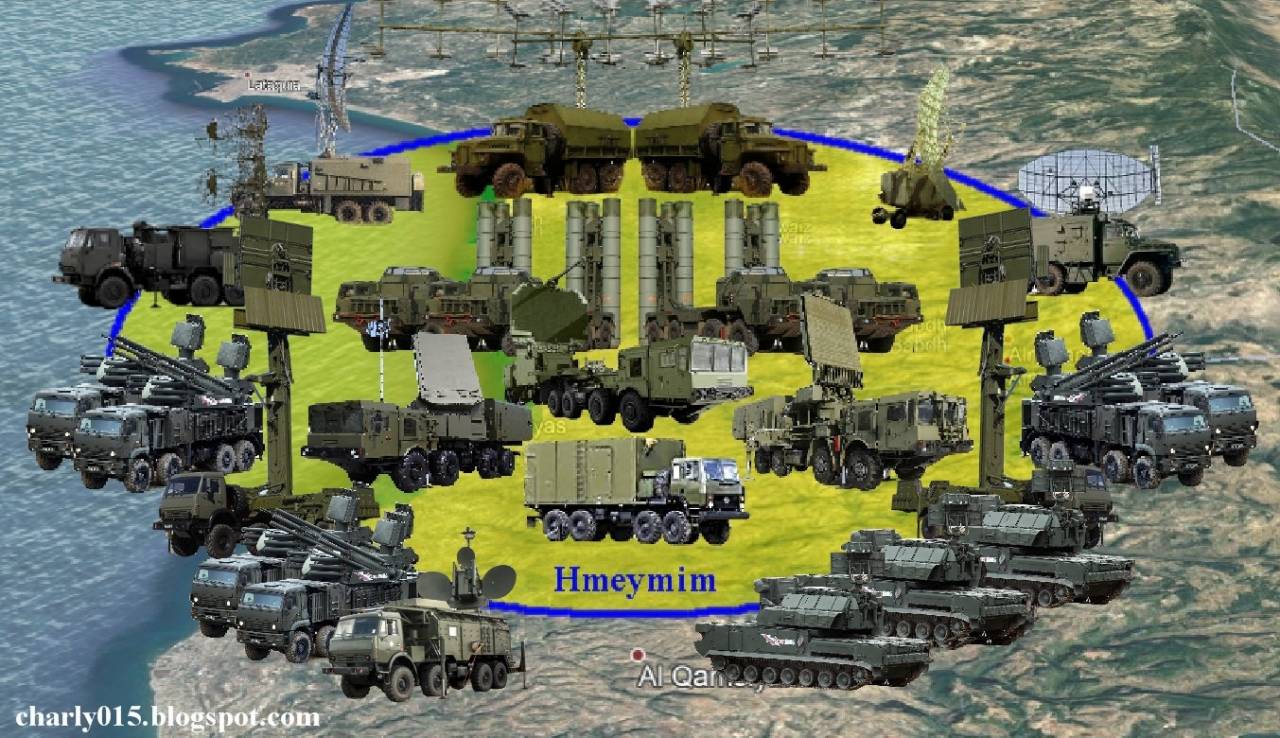
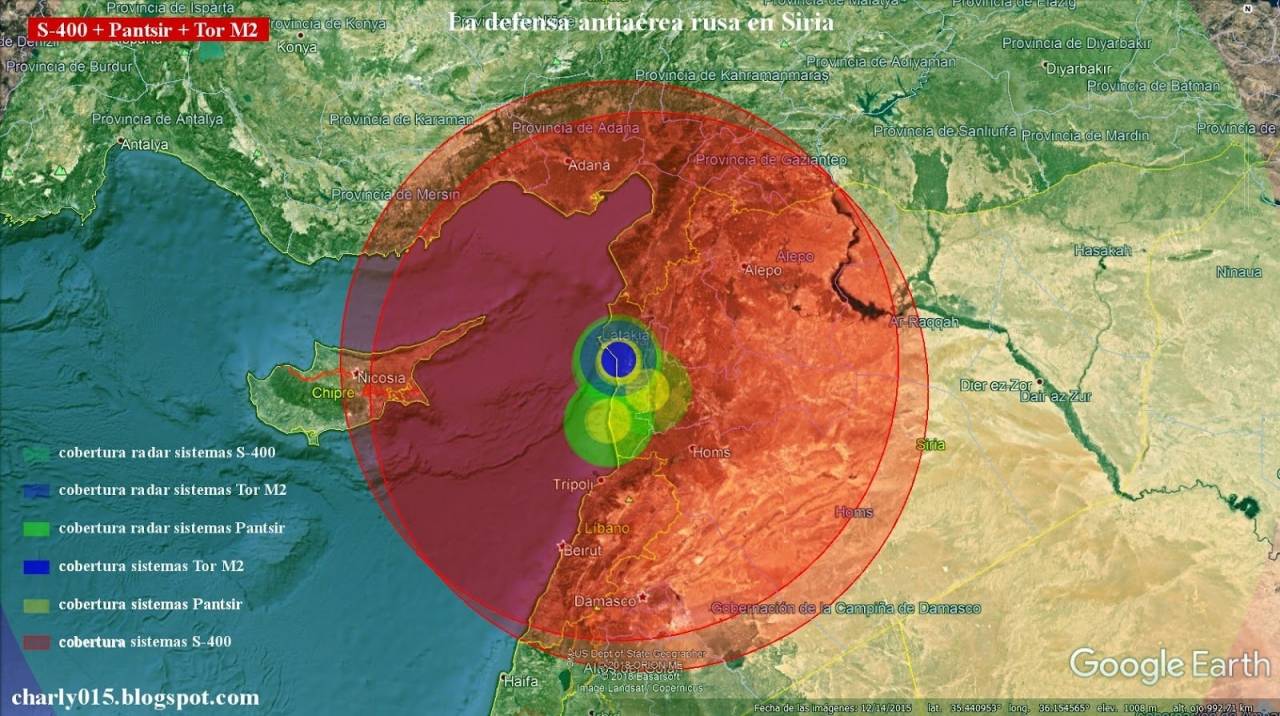

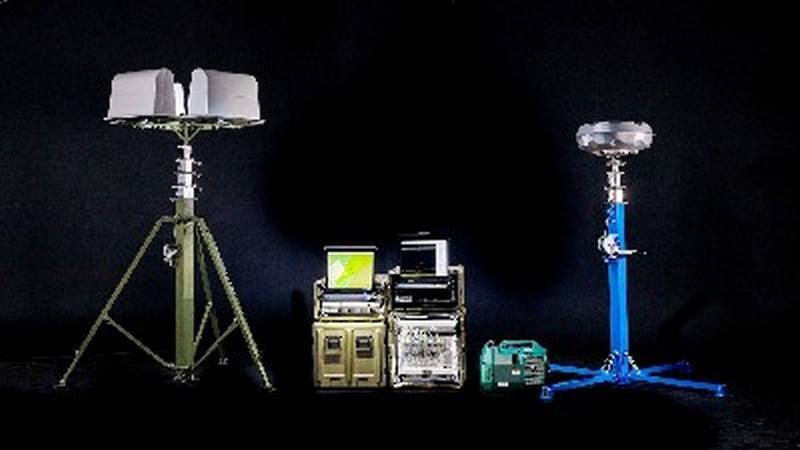
 Hole
Hole